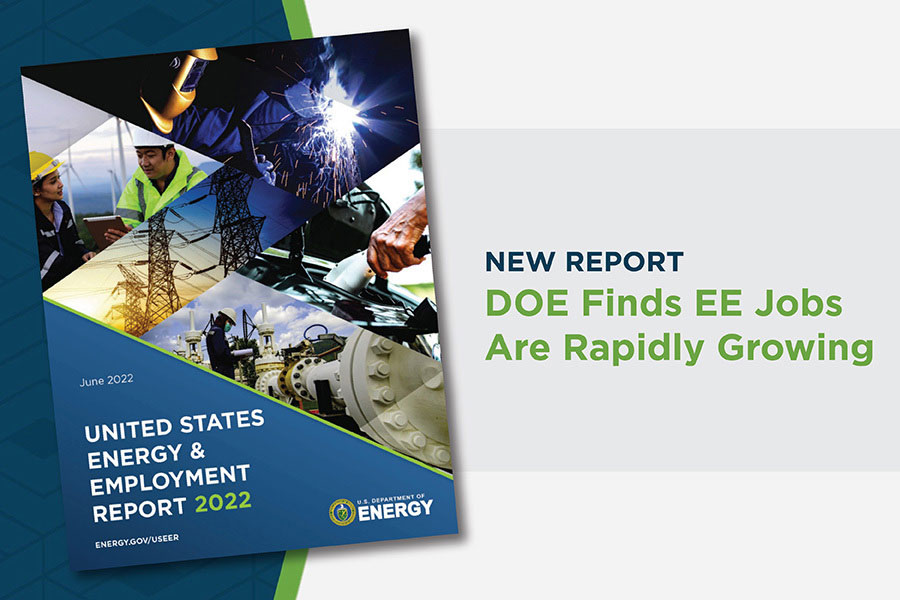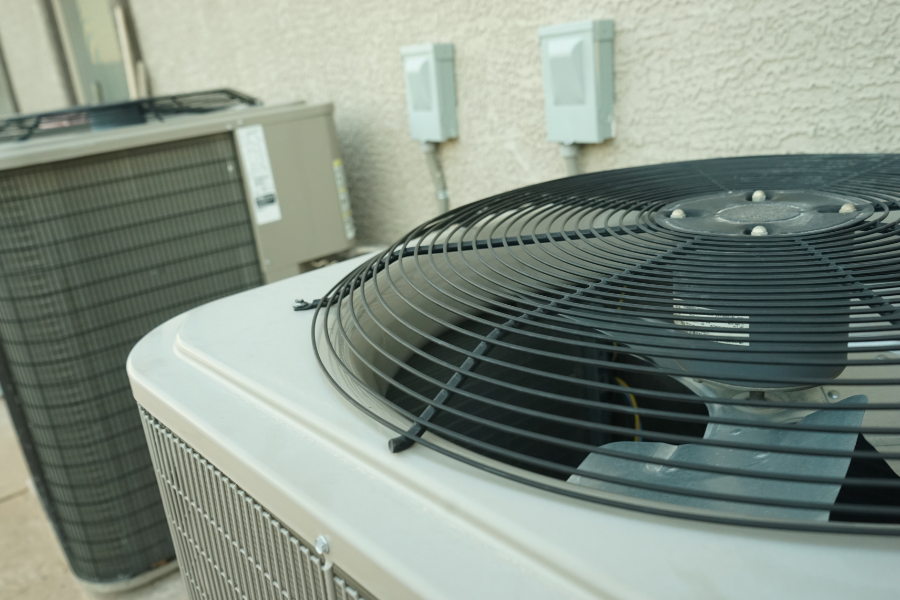Jun 29, 2022
DOE Report Finds Energy Jobs Grew Faster Than Overall U.S. Employment in 2021
The 2022 DOE report covers 2021, an unprecedented and unpredictable year for American families and businesses as the country began its slow recovery from the impacts of the COVID-19 pandemic.

On June 28, the U.S. Department of Energy (DOE) released the 2022 U.S. Energy and Employment Report (USEER), a comprehensive stdy designed to track and understand employment trends across the energy sector and within key energy technologies. The report covers 2021, an unprecedented and unpredictable year for American families and businesses as the country began its slow recovery from the impacts of the COVID-19 pandemic. Despite economic uncertainty, however, the USEER analysis shows the energy sector experienced positive job growth, increasing 4.0% from 2020 to 2021, outpacing overall U.S. employment, which climbed 2.8% in the same period. Overall, the total number of energy jobs increased, from 7.5 million in 2020 to more than 7.8 million in 2021, after a steep decline in 2020.
There are more than 3 million jobs, 40% of total energy jobs, that support reducing U.S. emissions to zero across several sectors—underscoring the pathway to success in reaching President Biden’s goal of a net-zero emissions economy by 2050. President Biden’s leadership, vision, and Bipartisan Infrastructure Law will help grow clean energy jobs at a remarkable pace, delivering good-paying opportunities to America’s workers in communities across the country.
“Amidst the unique challenges of a nation coming out of a global pandemic, America’s energy sector stands out with considerable job growth across nearly all industries,” said U.S. Secretary of Energy Jennifer M. Granholm. “DOE’s USEER report shows that jobs critical to our clean energy transition are on the rise and poised for continued expansion thanks to the historic investments from the President’s Bipartisan Infrastructure Law.”
The 2022 USEER, originally launched in 2016, covers five major energy industries: electric power generation; motor vehicles; energy efficiency; transmission, distribution, and storage; and fuels. The findings show that all industries, except for fuels, experienced net-positive job growth in 2021.
Sectors with notable job growth
- Electric vehicle jobs increased by 26.2%, adding 21,961 new jobs
- Hybrid electric vehicle jobs increased 19.7%, adding 23,577 new jobs
- Solar energy jobs increased by 5.4%, adding 17,212 new jobs
- Wind energy jobs increased by 2.9%, adding 3,347 new jobs
- Energy efficiency jobs increased by 2.7%, adding 57,741 new jobs
- Transmission, distribution, and storage jobs increased by 1.9%, adding 22,779 new jobs
States with notable job growth
Clean energy was a significant source of job growth in many states. The three states with the highest energy job growth numbers overall were Michigan, California, and Texas.
- Michigan gained 35,463 net jobs, which includes 5,136 new jobs in low or zero-carbon motor vehicles
- Texas gained 30,903 net jobs, which includes 4,858 new jobs in low or zero-carbon motor vehicles, 6,771 new jobs in in energy efficiency, and 1,610 new jobs in solar
- California gained 29,429 energy jobs, which includes 11,050 new jobs in in low or zero-carbon motor vehicles, 5,949 new jobs in energy efficiency, and 1,994 new jobs in solar
- West Virginia and Pennsylvania added the most jobs in transmission, distribution, and storage, gaining 7,321 and 5,726 new jobs, respectively
The 2022 USEER workforce and demographic analysis shows that 10% of workers in the energy sector are represented by a union or covered by project labor agreement, compared to 6% within the private sector nationally. The energy workforce also has a higher concentration of veterans than the U.S. workforce average (9% vs 6%).
Despite job growth, energy jobs have still not recovered to pre-pandemic, 2019 levels. While nearly all jobs in net-zero aligned areas experienced positive growth in 2021, only a few industries, including wind energy, electric vehicles, and hybrid-electric vehicles, had more jobs in 2021 than before the pandemic. Additionally, nuclear electricity, coal, and petroleum jobs decreased in 2021.
“Clean energy creates good-paying jobs, stimulates our economy and protects our environment. I’ve long pushed for consistent data collection to guide our policy on energy and workforce development. It’s promising to see such impressive growth in the energy sector in 2021 – which has helped our recovery from the pandemic in New Hampshire and across the nation,” said U.S. Senator Jeanne Shaheen (NH). “I look forward to sharing this data in the Senate to better inform our energy policies. I’ll keep working on bipartisan solutions that enhance clean energy and energy efficiency initiatives to build a more sustainable, resilient future.”
“Michigan’s economy is on the move and thanks to our hardworking people and innovative businesses, we are now a top three state for clean energy vehicle job growth,” said Michigan Governor Gretchen Whitmer. “We will continue fostering clean energy vehicle job growth and finding ways to pursue our long-term carbon neutrality goals too by expanding clean energy production and making energy efficient home repairs, lowering costs for families and communities. The clean energy future is bright, and Michigan is proud to be leading the way.”
“As the USEER 2022 report shows, clean energy sectors continue to grow, creating jobs across the country. As a nation, it is crucial that we do all that we can to ensure that the growth of these sectors continues and that the jobs created are good, union jobs. That is why it is so important the United States invests in clean energy, targeted to communities that need it most—including energy transition communities—and strong labor and domestic content standards. The Biden administration has made the creation of good, union jobs a core focus of their work to fight climate change. If we are to build a clean economy that works for all, we need many partners in that work,” said BlueGreen Alliance Executive Director Jason Walsh.
“The Department of Energy under the leadership of Secretary Granholm has worked tirelessly to advance pathways to the middle class that our unionized jobs create,” said Sean McGarvey, President of North America’s Building Trades Unions. “The three million men and women of North America’s Building Trades Unions who work every day to meet the energy demands of our country value the support of the Biden Administration, and we will continue creating opportunities for underserved communities to join our ranks and growing our participation in a modern, sustainable, and responsible energy industry.”
Investing in the Clean Energy Economy
The USEER demonstrates that achieving an equitable transition to a net-zero emissions economy-wide by 2050, with a diverse workforce, will require additional public and private investments in the clean energy sector. It will also require commitment from industry to support workers, by creating stable and secure good-paying jobs and investing in education and training programs to help workers, of all backgrounds, advance their clean energy careers.
Going forward, President Biden’s Bipartisan Infrastructure Law provides significant investments in clean energy infrastructure, including $62 billion for DOE to expand access to energy efficiency; deliver reliable, clean, and affordable power to more Americans; and build the technologies of tomorrow. The Law also supports transitioning energy communities with investments of $750M for manufacturing in coal communities and $500M for clean energy demonstrations on mine lands.
The 2022 USEER is based on surveys of approximately 33,000 private energy businesses combined with public labor data to produce estimates of employment and workforce characteristics.
The full report, state report, and fact sheet can be found at www.energy.gov/useer.





